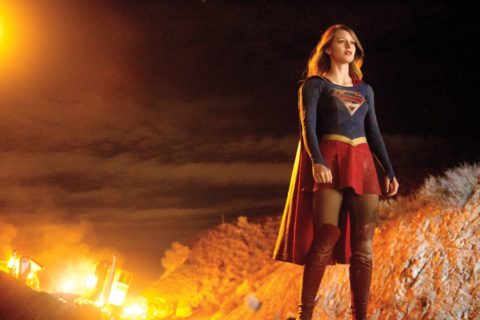Supergirl and the legacy of the unsuspecting female superhero

This week, Supergirl became one of the highest rated TV show of the season.
Tying with Blindspot, the story of Kara Zor-El (played by Melissa Benoist), the first Supergirl with her own series, has dazzled the masses, making it a straight-up hit after debuting to 12.95 million viewers.
Add this to the hyper for the recently-released trailer for Netflix’s Jessica Jones (a superhero series by Marvel), and I think we’re seeing the start of a female superhero renaissance. Especially since both characters—like most female superheroes—are never suspected.
And this is just one of the biggest jumps that mark an evolution from the days of superheroes like Lynda Carter as Wonder Woman. Did Wonder Woman rule? Of course. But she also stood out. Her ensemble was bright, it included a crown, and it screamed stereotypical femininity in a way that marketed her as much to men as it did to women. Arguably, her’s was a costume, not a uniform, and it was designed to make a splash just as much as it was designed to help defeat her enemies. It was painted with the brush of optimism, where her aesthetic helped position her on the side of “good.” She never looked like her enemies because she wasn’t like them.
But our modern-day superheroes are. Avengers’ Natasha Romanoff (a.k.a. Black Widow) was plucked from a Russian spy ring and brought over to S.H.I.E.L.D., where her costume — a black leotard — allowed her room not just to fight, but to camouflage among the opposition. Unlike Thor, Captain America (who’s more clean-cut and dressed in the same patriotic style as Wonder Woman), or The Hulk (who can’t hide once he’s transformed), she joins Hawkeye in terms of the ability to blend. In neutrals, they represent both sides of the fence, since they’ve both worked them. Theirs are uniforms of necessity, not as a means of showing off.
The same can be said for Storm in X-Men, whose stark white hair is the only thing that differentiates her from the rest of the pack—especially since her one-piece is similar to the ones worn by the men around her. Meanwhile Mystique, whose body is blue and stands out accordingly, relies on morphing into whoever she needs to be to save herself and to complete her missions. Both characters are unsuspecting and overlooked because they can blend in—no one suspects them until it’s too late. (Especially since by the time Storm summons a blizzard, it’s too late. Similar to Mystique, who’s likely seconds away from killing you before you know that it’s her.)
This year, however, marks even more of an evolution from the gritter female superhero instalments. On the one hand, Jessica Jones’ narrative follows a film noir-type trajectory: her story is dark, her surroundings are dim, and her abilities were once rooted in her enemy’s intentions. She dresses like everybody, and she has no uniform because she’s completely alone. Her survival depends on her ability to blend in and hide from the man trying to kill her, despite her need to help other people (which makes her stand out). Her aesthetic isn’t set, but it’s defined by the shadows. Which is the literal opposite of Supergirl.
Supergirl, as we know, is a woman of light, and her uniform fits her accordingly. Bathed in blue and red, and a cape and a skirt (which we saw decided on in the pilot when she rejects a costume that’s too sexy and settles for something that reflects her teen girl personality), she’s never worked in the shadows, nor does she relate to the people who dwell in them. She has no need to hide or blend because her powers ensure her relative safety — and in the daytime when she does blend, she’s off duty. If she ever needed to hide among people trying to hurt her, she could put on her Supergirl threads and fight accordingly. Jessica Jones’ world isn’t her’s, despite both living the city life. There’s a freedom to Supergirl that we don’t tend to see reflected in the pieces worn by other female superheroes.
Which is actually what makes this instalment of Supergirl so important. While the importance of blending or moving unsuspectingly is key to helping forward a narrative (as we know from watching comic book movies), there’s more than one way to be a female crimefighter—especially since the costumes and/or uniforms of male superheroes are so vast. Sure, we’ve stepped away from our heroes needing to be #sexy, but like there’s more than one way to be a woman, there’s more than one way to be a female superhero.
Meaning that even though we’re no longer living the Lynda Carter life, she’s still a boss for putting such a stylish superhero on the map.







